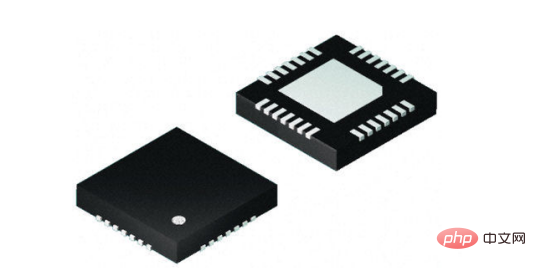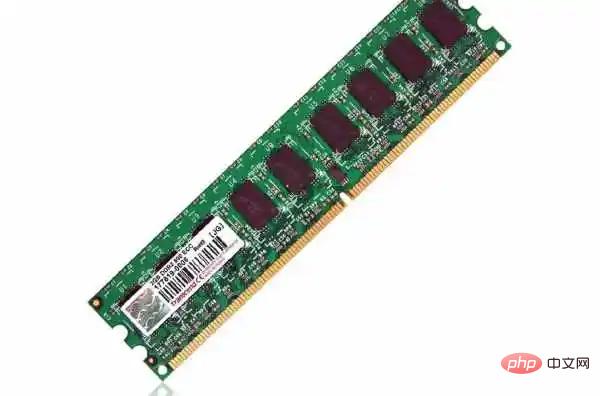What memory can the CPU directly access?
The memory that the CPU can directly access is: internal memory. Internal memory, also known as memory, is a storage space that the CPU can directly address and is made of semiconductor devices. Internal memory is the bridge between external memory and the CPU. All programs in the computer run in memory. As long as the computer is running, the operating system will transfer the data that needs to be calculated from the memory to the CPU for calculation; when the calculation is completed, the CPU will transmit the results. The operation of the memory also determines the stable operation of the computer.

The operating environment of this tutorial: Windows 7 system, Dell G3 computer.
Internal memory is a storage space that the CPU can directly address and is made of semiconductor devices. It is characterized by fast access speed.
Internal memory, also known as memory, is one of the important components in the computer. It is the bridge between external memory and the CPU. All programs in the computer run in the memory.
The performance of memory has a great impact on the computer. The function of memory is to temporarily store calculation data in the CPU and data exchanged with external memories such as hard disks.
As long as the computer is running, the operating system will transfer the data that needs to be calculated from the memory to the CPU for calculation. When the operation is completed, the CPU transmits the results, and the operation of the memory also determines the stable operation of the computer.

#Memory is the main component in the computer, which is relative to external memory.
The programs we usually use, such as: Windows operating system, typing software, game software, etc. They are generally installed on external storage such as hard disks, but their functions cannot be used only because they must be transferred into memory to run in order to truly use their functions.
When we usually enter a piece of text or play a game, we actually do it in memory. Just like in a study room, the bookshelves and bookcases where books are stored are equivalent to the external storage of the computer, and the desk where we work is equivalent to the memory.
Usually, we store large amounts of data that need to be saved permanently on external memory, and put some temporary or small amounts of data and programs on memory. Of course, the quality of the memory will directly affect the running speed of the computer.
Memory is a place where programs and data are temporarily stored. When we use WPS to process a document, when you type characters on the keyboard, it is stored in memory. When you choose to save, the data in the memory will be saved to the hard (disk) disk.

Types of internal memory
Internal memory is composed of random access memory and read-only memory constituted.
Read-Only Memory (ROM)
Read-Only Memory (ROM) works in a non-destructive readout mode and can only be read but not written Enter information. Once the information is written, it is fixed and will not be lost even if the power is turned off, so it is also called fixed memory. The data stored in ROM is usually written before being loaded into the whole machine. It can only be read out during the operation of the whole machine. Unlike random access memory, the stored content can be rewritten quickly and conveniently. The data stored in ROM is stable and will not change after a power outage. It has a simple structure and is easy to use, so it is often used to store various fixed programs and data.
The characteristic of ROM is that it can only read information but cannot write information. Usually, a basic input/output system is solidified in the ROM of the computer motherboard, called BIOS (Basic Input Output System). Its main function is to complete the power-on self-test of the system, initialization of each functional module in the system, basic input/output driver of the system and boot operating system.
There are many types of ROM, and each type of read-only memory has its own characteristics and scope of application. According to its manufacturing process and function, there are five types of ROM, namely mask-programmed read-only memory MROM (Mask-programmed ROM), programmable read-only memory PROM (Programmable ROM), erasable and programmable read-only memory Memory EPROM (Erasable Programmable ROM), electrically erasable programmable read-only memory EEPROM (Electrically Erasable Programmable ROM) and flash erasable read-write memory (Flash Memory).
Random Access Memory (RAM)
Random Access Memory (English: Random Access Memory, abbreviation: RAM), also called main memory, exchanges data directly with the CPU of internal memory. It can be read and written at any time (except when refreshing), is very fast, and is often used as a temporary data storage medium for the operating system or other running programs. When RAM is working, information can be written (stored) or read (retrieved) from any specified address at any time. The biggest difference between it and ROM is the volatility of data, that is, the stored data will be lost once the power is turned off. RAM is used in computers and digital systems to temporarily store programs, data, and intermediate results.
Characteristics of RAM:
-
Random access
The so-called "random access" means that when data in the memory is read or written, the time required has nothing to do with the location of the information or the location where it is written. In contrast, when reading or writing information in a Sequential Access storage device, the time and location required are related. It is mainly used to store the operating system, various applications, data, etc.
When RAM is working normally, data can be read from RAM or written to RAM. Compared with ROM, RAM has the advantages of easy reading/writing and flexible use. It is especially suitable for situations where data is frequently and quickly changed.
-
Volatile
RAM cannot retain data when the power is turned off. If data needs to be saved, they must be written to a long-term storage device (such as a hard drive).
The working characteristic of RAM is that after power is turned on, data information can be accessed at any location at any time, and the internal information will disappear after power is turned off.
-
Sensitive to static electricity
Like other delicate integrated circuits, random access memory is very sensitive to electrostatic charges in the environment. Static electricity can interfere with the charge of the capacitors in the memory, causing data loss or even burning out the circuit. Therefore, before touching the random access memory, you should first touch the metal ground with your hand.
-
Access speed
Modern random access memory has the fastest writing and reading speeds among almost all access devices, with access delays and other mechanical operations involved. It is also insignificant compared to other storage devices.
-
Requires Refresh
Modern random access memories rely on capacitors to store data. A fully charged capacitor represents a 1 (binary), and an uncharged capacitor represents a 0. Since capacitors have leakage to some extent, data will gradually be lost over time if no special treatment is taken. Refreshing means periodically reading the status of the capacitor and then recharging the capacitor according to its original status to make up for the lost charge. The need to refresh explains exactly the volatile nature of random access memory.
For more related knowledge, please visit: PHP Chinese website!
The above is the detailed content of What memory can the CPU directly access?. For more information, please follow other related articles on the PHP Chinese website!

Hot AI Tools

Undresser.AI Undress
AI-powered app for creating realistic nude photos

AI Clothes Remover
Online AI tool for removing clothes from photos.

Undress AI Tool
Undress images for free

Clothoff.io
AI clothes remover

Video Face Swap
Swap faces in any video effortlessly with our completely free AI face swap tool!

Hot Article

Hot Tools

Notepad++7.3.1
Easy-to-use and free code editor

SublimeText3 Chinese version
Chinese version, very easy to use

Zend Studio 13.0.1
Powerful PHP integrated development environment

Dreamweaver CS6
Visual web development tools

SublimeText3 Mac version
God-level code editing software (SublimeText3)

Hot Topics
 1389
1389
 52
52
 What should the CPU utilization be when gaming?
Feb 19, 2024 am 11:21 AM
What should the CPU utilization be when gaming?
Feb 19, 2024 am 11:21 AM
It's common for games to slow down your computer because they consume a lot of resources. It's crucial to understand your CPU usage when gaming so you can avoid overloading it. Therefore, keeping track of appropriate CPU usage is key to keeping your gaming experience smooth. In this article, we'll look at the appropriate CPU usage you should achieve while your game is running. CPU utilization during gaming CPU utilization is an important indicator of processor workload and depends on the performance specifications of the CPU. More powerful CPUs generally have higher usage. A CPU with more cores and threads can improve the overall performance of your system. Multi-threading support helps unleash the full potential of your CPU. In games, CPU usage depends on processor utilization, which can affect the game
 How to set CPU performance to full in Win11
Feb 19, 2024 pm 07:42 PM
How to set CPU performance to full in Win11
Feb 19, 2024 pm 07:42 PM
Many users find that the computer is not running smoothly enough when using the Win11 system. They want to improve CPU performance, but they don't know how to do it. The following will introduce in detail how to set the CPU performance to the highest level in Win11 system to make your computer more efficient. Setting method: 1. Right-click "This PC" on the desktop and select "Properties" in the option list. 2. After entering the new interface, click "Advanced System Settings" in "Related Links". 3. In the window that opens, click the "Advanced" tab at the top, then click the & at the bottom of "Performance"
 How to undervolt and overclock your CPU using Intel XTU
Feb 19, 2024 am 11:06 AM
How to undervolt and overclock your CPU using Intel XTU
Feb 19, 2024 am 11:06 AM
Intel XTU is a powerful application that allows you to easily manage your computer's performance. You can fix overheating issues by adjusting the CPU voltage, or boost performance by overclocking. In this article, we'll look at how you can take advantage of Intel XTU to optimize your computer's performance, whether that's adjusting voltage or overclocking. What effect do undervolting and overclocking have on the CPU? Before we move on to learning how to undervolt and overclock a CPU, we first have to understand what they are. Undervolting refers to gradually reducing the voltage required by the CPU. This process helps reduce heat emissions, as high voltage results in higher temperatures. By reducing the voltage supply to the CPU, the temperature can be effectively reduced. If your laptop starts to slow down after getting hot, you should solve the problem promptly.
 The difference between boxed and bulk cpu
Jan 23, 2024 am 09:46 AM
The difference between boxed and bulk cpu
Jan 23, 2024 am 09:46 AM
The differences between boxed and bulk CPUs: 1. Quality; 2. Warranty period; 3. Fan; 4. Price; 5. Packaging; 6. Sales channels. Detailed introduction: 1. Quality, whether it is boxed or bulk, there is no difference in the quality of the CPU itself. They are all manufactured by the same manufacturer and undergo the same quality testing and quality control process; 2. Warranty period, boxed CPU A longer warranty period is usually provided, usually three years, while bulk CPUs usually only have a one-year warranty, this is because boxed CPUs are usually sold by official or authorized dealers, etc.
 How to increase the clock frequency of your computer's CPU
Feb 20, 2024 am 09:54 AM
How to increase the clock frequency of your computer's CPU
Feb 20, 2024 am 09:54 AM
How to Overclock Computer CPUs With the continuous advancement of technology, people's demand for computer performance is also getting higher and higher. An effective way to improve computer performance is to increase the CPU's operating frequency through overclocking. Overclocking allows the CPU to process data faster, providing higher computing power. So, how to overclock a computer CPU? The following will introduce you to the basic principles and specific operation methods of overclocking. First, let's understand how overclocking works. The operating frequency of the CPU is determined by the crystal oscillator on the motherboard
 The operation process of WIN10 service host occupying too much CPU
Mar 27, 2024 pm 02:41 PM
The operation process of WIN10 service host occupying too much CPU
Mar 27, 2024 pm 02:41 PM
1. First, we right-click the blank space of the taskbar and select the [Task Manager] option, or right-click the start logo, and then select the [Task Manager] option. 2. In the opened Task Manager interface, we click the [Services] tab on the far right. 3. In the opened [Service] tab, click the [Open Service] option below. 4. In the [Services] window that opens, right-click the [InternetConnectionSharing(ICS)] service, and then select the [Properties] option. 5. In the properties window that opens, change [Open with] to [Disabled], click [Apply] and then click [OK]. 6. Click the start logo, then click the shutdown button, select [Restart], and complete the computer restart.
 144-core, 3D-stacked SRAM: Fujitsu details next-generation data center processor MONAKA
Jul 29, 2024 am 11:40 AM
144-core, 3D-stacked SRAM: Fujitsu details next-generation data center processor MONAKA
Jul 29, 2024 am 11:40 AM
According to news from this website on July 28, foreign media TechRader reported that Fujitsu introduced in detail the FUJITSU-MONAKA (hereinafter referred to as MONAKA) processor planned to be shipped in 2027. MONAKACPU is based on the "cloud native 3D many-core" architecture and adopts the Arm instruction set. It is oriented to the data center, edge and telecommunications fields. It is suitable for AI computing and can realize mainframe-level RAS1. Fujitsu said that MONAKA will achieve a leap in energy efficiency and performance: thanks to technologies such as ultra-low voltage (ULV) technology, the CPU can achieve 2 times the energy efficiency of competing products in 2027, and cooling does not require water cooling; in addition, the application performance of the processor It can also reach twice as much as your opponent. In terms of instructions, MONAKA is equipped with vector
 Leak reveals key specs of Intel Arrow Lake-U, -H, -HX and -S
Jun 15, 2024 pm 09:49 PM
Leak reveals key specs of Intel Arrow Lake-U, -H, -HX and -S
Jun 15, 2024 pm 09:49 PM
IntelArrowLakeisexpectedtobebasedonthesameprocessorarchitectureasLunarLake,meaningthatIntel'sbrandnewLionCoveperformancecoreswillbecombinedwiththeeconomicalSkymontefficiencycores.WhileLunarLakeisonlyavailableasava



